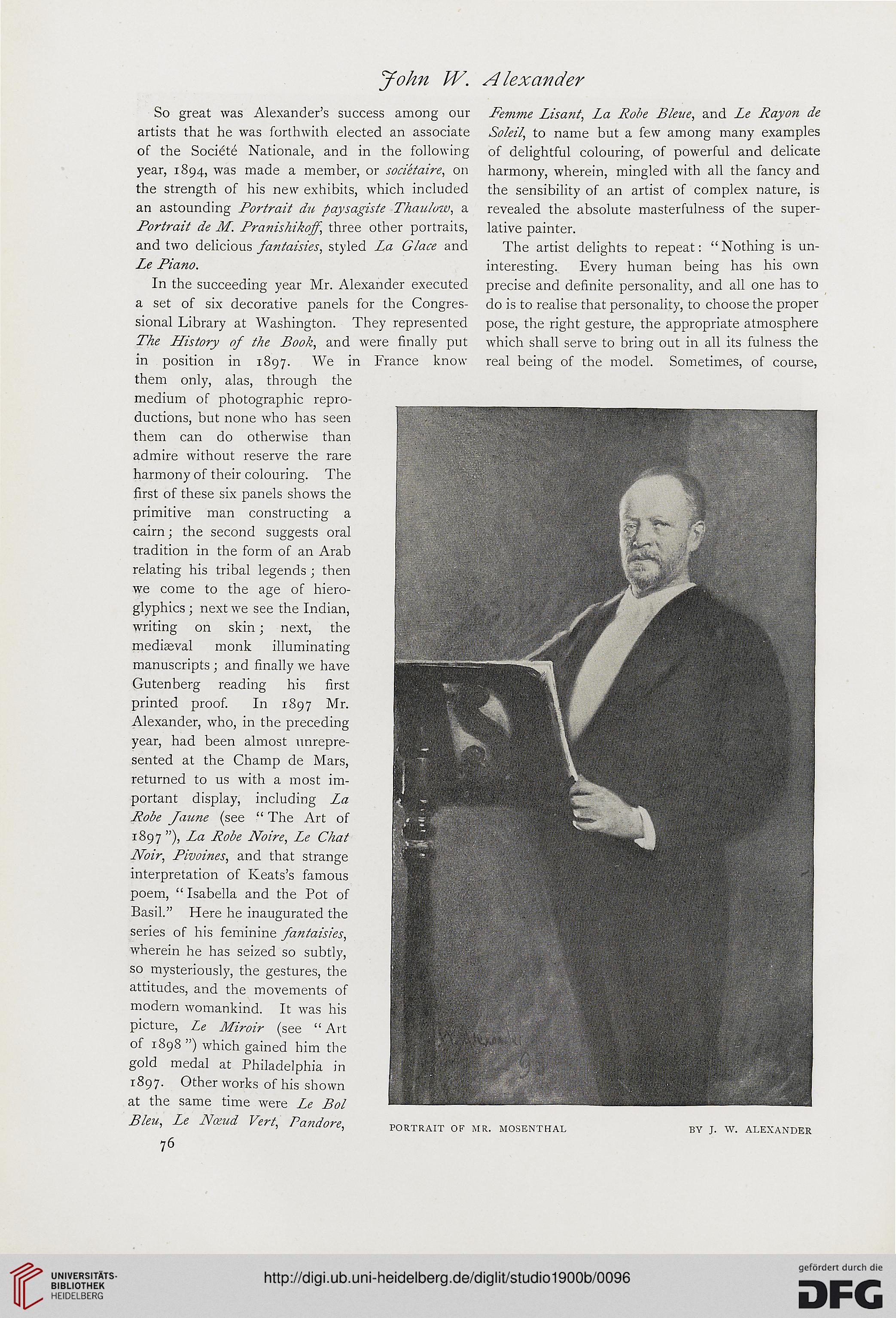John W. Alexander
So great was Alexander's success among our Femme Lisant, La Robe Bleue, and Le Rayon de
artists that he was forthwith elected an associate Soldi, to name but a few among many examples
of the Societe Nationale, and in the following of delightful colouring, of powerful and delicate
year, 1894, was made a member, or societaire, on harmony, wherein, mingled with all the fancy and
the strength of his new exhibits, which included the sensibility of an artist of complex nature, is
an astounding Portrait du paysagiste Thaulow, a revealed the absolute masterfulness of the super-
Portrait de M. Pranishikojf, three other portraits, lative painter.
and two delicious fantaisies, styled La Glace and The artist delights to repeat: " Nothing is un-
Le Piano. interesting. Every human being has his own
In the succeeding year Mr. Alexander executed precise and definite personality, and all one has to
a set of six decorative panels for the Congres- do is to realise that personality, to choose the proper
sional Library at Washington. They represented pose, the right gesture, the appropriate atmosphere
The History of the Book, and were finally put which shall serve to bring out in all its fulness the
in position in 1897. We in France know real being of the model. Sometimes, of course,
them only, alas, through the
medium of photographic repro-
ductions, but none who has seen
them can do otherwise than
admire without reserve the rare
harmony of their colouring. The
first of these six panels shows the
primitive man constructing a
cairn; the second suggests oral
tradition in the form of an Arab
relating his tribal legends ; then
we come to the age of hiero-
glyphics ; next we see the Indian,
writing on skin; next, the
mediaeval monk illuminating
manuscripts ; and finally we have
Gutenberg reading his first
printed proof. In 1897 Mr.
Alexander, who, in the preceding
year, had been almost unrepre-
sented at the Champ de Mars,
returned to us with a most im-
portant display, including La
Robe Jaune (see " The Art of
1897 "), La Robe Noire, Le Chat
Noir, Pivoines, and that strange
interpretation of Keats's famous
poem, " Isabella and the Pot of
Basil." Here he inaugurated the
series of his feminine fantaisies,
wherein he has seized so subtly,
so mysteriously, the gestures, the
attitudes, and the movements of
modern womankind. It was his
picture, Le Miroir ( see " Art
of 1898 ") which gained him the
gold medal at Philadelphia in
1897. Other works of his shown
at the same time were Le Bol
Bleu, Le JVceud Vert, Pandore, portrait of mr. mosenthal by j. w. Alexander
76
So great was Alexander's success among our Femme Lisant, La Robe Bleue, and Le Rayon de
artists that he was forthwith elected an associate Soldi, to name but a few among many examples
of the Societe Nationale, and in the following of delightful colouring, of powerful and delicate
year, 1894, was made a member, or societaire, on harmony, wherein, mingled with all the fancy and
the strength of his new exhibits, which included the sensibility of an artist of complex nature, is
an astounding Portrait du paysagiste Thaulow, a revealed the absolute masterfulness of the super-
Portrait de M. Pranishikojf, three other portraits, lative painter.
and two delicious fantaisies, styled La Glace and The artist delights to repeat: " Nothing is un-
Le Piano. interesting. Every human being has his own
In the succeeding year Mr. Alexander executed precise and definite personality, and all one has to
a set of six decorative panels for the Congres- do is to realise that personality, to choose the proper
sional Library at Washington. They represented pose, the right gesture, the appropriate atmosphere
The History of the Book, and were finally put which shall serve to bring out in all its fulness the
in position in 1897. We in France know real being of the model. Sometimes, of course,
them only, alas, through the
medium of photographic repro-
ductions, but none who has seen
them can do otherwise than
admire without reserve the rare
harmony of their colouring. The
first of these six panels shows the
primitive man constructing a
cairn; the second suggests oral
tradition in the form of an Arab
relating his tribal legends ; then
we come to the age of hiero-
glyphics ; next we see the Indian,
writing on skin; next, the
mediaeval monk illuminating
manuscripts ; and finally we have
Gutenberg reading his first
printed proof. In 1897 Mr.
Alexander, who, in the preceding
year, had been almost unrepre-
sented at the Champ de Mars,
returned to us with a most im-
portant display, including La
Robe Jaune (see " The Art of
1897 "), La Robe Noire, Le Chat
Noir, Pivoines, and that strange
interpretation of Keats's famous
poem, " Isabella and the Pot of
Basil." Here he inaugurated the
series of his feminine fantaisies,
wherein he has seized so subtly,
so mysteriously, the gestures, the
attitudes, and the movements of
modern womankind. It was his
picture, Le Miroir ( see " Art
of 1898 ") which gained him the
gold medal at Philadelphia in
1897. Other works of his shown
at the same time were Le Bol
Bleu, Le JVceud Vert, Pandore, portrait of mr. mosenthal by j. w. Alexander
76




